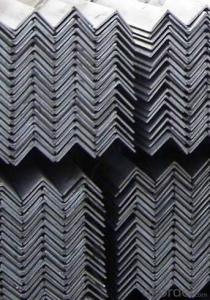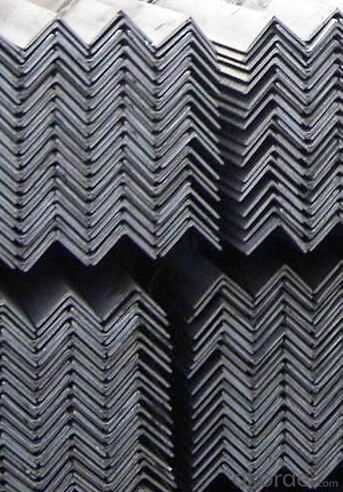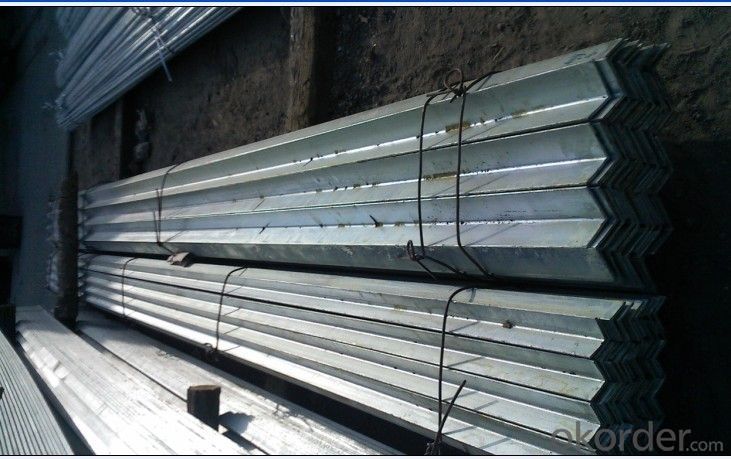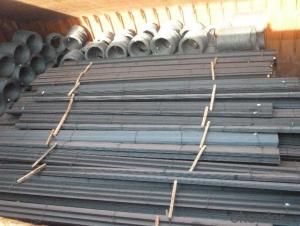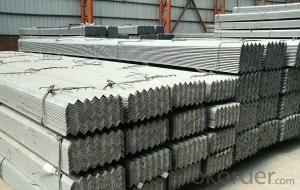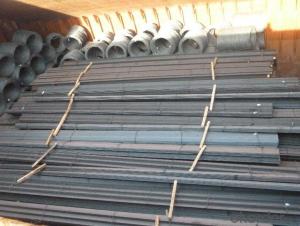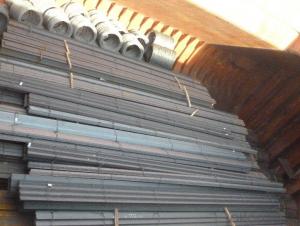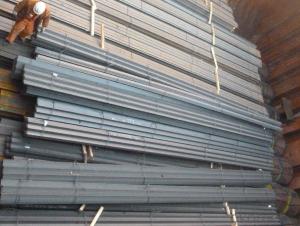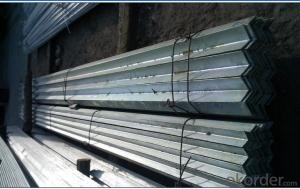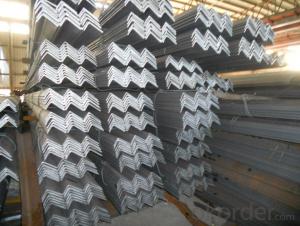Low Carbon Hot Rolled Steel Equal Angle Bars
- Loading Port:
- Tianjin
- Payment Terms:
- TT or LC
- Min Order Qty:
- 100 m.t.
- Supply Capability:
- 20000 m.t./month
OKorder Service Pledge
OKorder Financial Service
You Might Also Like
OKorder is offering Low Carbon Hot Rolled Steel Equal Angle Bars at great prices with worldwide shipping. Our supplier is a world-class manufacturer of steel, with our products utilized the world over. OKorder annually supplies products to African, South American and Asian markets. We provide quotations within 24 hours of receiving an inquiry and guarantee competitive prices.
Product Applications:
Low Carbon Hot Rolled Steel Equal Angle Barsare ideal for structural applications and are widely used in the construction of buildings and bridges, and the manufacturing, petrochemical, and transportation industries
Product Advantages:
OKorder's Low Carbon Hot Rolled Steel Equal Angle Bars are durable, strong, and wide variety of sizes.
Main Product Features:
· Premium quality
· Prompt delivery & seaworthy packing (30 days after receiving deposit)
· Can be recycled and reused
· Mill test certification
· Professional Service
· Competitive pricing
Product Specifications:
Manufacture: Hot rolled
Grade: Q195 – 235
Certificates: ISO, SGS, BV, CIQ
Length: 6m – 12m, as per customer request
Packaging: Export packing, nude packing, bundled
| EQUAL ANGLE STEEL | |||||
| size(mm) | a(mm) | a1(mm) | thickness(mm) | kg/m | length |
| 50*50*4 | 50 | 50 | 4 | 3.059 | 6m,9m,12m |
| 50*50*5 | 50 | 50 | 5 | 3.77 | 6m,9m,12m |
| 50*50*6 | 50 | 50 | 6 | 4.465 | 6m,9m,12m |
| 63*63*5 | 63 | 63 | 5 | 4.822 | 6m,9m,12m |
| 63*63*6 | 63 | 63 | 6 | 5.721 | 6m,9m,12m |
| 65*65*5 | 65 | 65 | 5 | 5 | 6m,9m,12m |
| 65*65*6 | 65 | 65 | 6 | 5.91 | 6m,9m,12m |
| 65*65*8 | 65 | 65 | 8 | 7.66 | 6m,9m,12m |
| 75*75*5 | 75 | 75 | 5 | 5.818 | 6m,9m,12m |
| 75*75*6 | 75 | 75 | 6 | 6.905 | 6m,9m,12m |
| 75*75*8 | 75 | 75 | 8 | 9.03 | 6m,9m,12m |
| 75*75*9 | 75 | 75 | 9 | 9.96 | 6m,9m,12m |
| 75*75*10 | 75 | 75 | 10 | 11.089 | 6m,9m,12m |
| 80*80*6 | 80 | 80 | 6 | 7.375 | 6m,9m,12m |
| 80*80*7 | 80 | 80 | 7 | 8.525 | 6m,9m,12m |
| 80*80*8 | 80 | 80 | 8 | 9.658 | 6m,9m,12m |
| 80*80*10 | 80 | 80 | 10 | 11.874 | 6m,9m,12m |
| 90*90*6 | 90 | 90 | 6 | 8.35 | 6m,9m,12m |
| 90*90*7 | 90 | 90 | 7 | 9.656 | 6m,9m,12m |
| 90*90*8 | 90 | 90 | 8 | 10.946 | 6m,9m,12m |
| 90*90*10 | 90 | 90 | 10 | 13.476 | 6m,9m,12m |
| 100*100*6 | 100 | 100 | 6 | 9.366 | 6m,9m,12m |
| 100*100*7 | 100 | 100 | 7 | 10.83 | 6m,9m,12m |
| 100*100*8 | 100 | 100 | 8 | 12.276 | 6m,9m,12m |
| 100*100*9 | 100 | 100 | 9 | 13.49 | 6m,9m,12m |
| 100*100*10 | 100 | 100 | 10 | 15.12 | 6m,9m,12m |
| 100*100*12 | 100 | 100 | 12 | 17.898 | 6m,9m,12m |
| 120*120*8 | 120 | 120 | 8 | 14.88 | 6m,9m,12m |
| 120*120*10 | 120 | 120 | 10 | 18.37 | 6m,9m,12m |
| 120*120*12 | 120 | 120 | 12 | 21.66 | 6m,9m,12m |
| 125*125*8 | 125 | 125 | 8 | 15.504 | 6m,9m,12m |
| 125*125*10 | 125 | 125 | 10 | 19.133 | 6m,9m,12m |
| 125*125*12 | 125 | 125 | 12 | 22.696 | 6m,9m,12m |
| 130*130*10 | 130 | 130 | 10 | 19.8 | 6m,9m,12m |
| 130*130*12 | 130 | 130 | 12 | 23.6 | 6m,9m,12m |
| 130*130*13 | 130 | 130 | 13 | 25.4 | 6m,9m,12m |
| 130*130*14 | 130 | 130 | 14 | 27.2 | 6m,9m,12m |
| 150*150*10 | 150 | 150 | 10 | 23 | 6m,9m,12m |
| 150*150*12 | 150 | 150 | 12 | 27.3 | 6m,9m,12m |
| 150*150*14 | 150 | 150 | 14 | 31.6 | 6m,9m,12m |
| 150*150*15 | 150 | 150 | 15 | 33.8 | 6m,9m,12m |
| 140*140*10 | 140 | 140 | 10 | 21.49 | 6m,9m,12m |
| 140*140*12 | 140 | 140 | 12 | 25.52 | 6m,9m,12m |
| 140*140*14 | 140 | 140 | 14 | 29.49 | 6m,9m,12m |
| 160*160*10 | 160 | 160 | 10 | 24.73 | 6m,9m,12m |
| 160*160*12 | 160 | 160 | 12 | 29.39 | 6m,9m,12m |
| 160*160*14 | 160 | 160 | 14 | 33.99 | 6m,9m,12m |
| 180*180*12 | 180 | 180 | 12 | 33.16 | 6m,9m,12m |
| 180*180*14 | 180 | 180 | 14 | 39.39 | 6m,9m,12m |
| 180*180*16 | 180 | 180 | 16 | 43.45 | 6m,9m,12m |
| 180*180*18 | 180 | 180 | 18 | 48.63 | 6m,9m,12m |
| 200*200*14 | 200 | 200 | 14 | 42.89 | 6m,9m,12m |
| 200*200*16 | 200 | 200 | 16 | 48.68 | 6m,9m,12m |
| 200*200*18 | 200 | 200 | 18 | 54.4 | 6m,9m,12m |
| 200*200*20 | 200 | 200 | 20 | 60.06 | 6m,9m,12m |
| 200*200*24 | 200 | 200 | 24 | 71.17 | 6m,9m,12m |
FAQ:
Q1: How do we guarantee the quality of our products?
A1: We have established an advanced quality management system which conducts strict quality tests at every step, from raw materials to the final product. At the same time, we provide extensive follow-up service assurances as required.
Q2: How soon can we receive the product after purchase?
A2: Within three days of placing an order, we will arrange production. The normal sizes with the normal grade can be produced within one month. The specific shipping date is dependent upon international and government factors, the delivery to international main port about 45-60days.
Q3: How many tons of steel products could be loaded in containers?
A3: Usually the steel products are delivered by bulk vessel because of the large quantity and the freight. However, there are no bulk vessel enter some seaports so that we have to deliver the cargo by containers. The 6m steel product can be loaded in 20FT container, but the quantity is changed according to the size, usually from 18tons to 25tons.
Images:
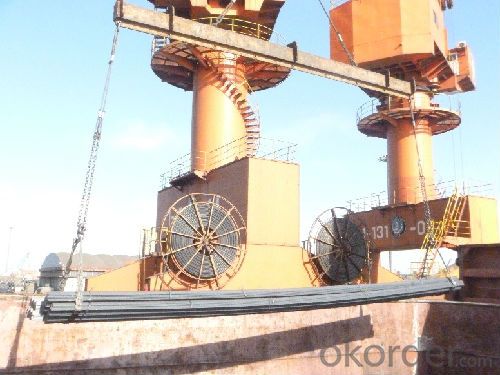
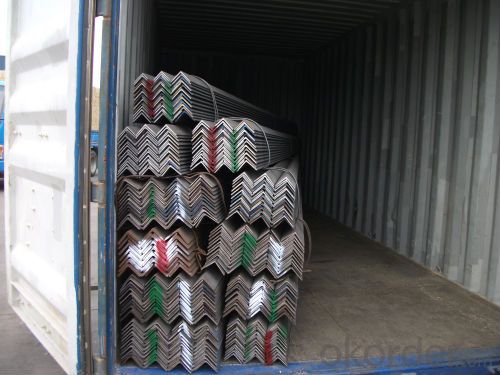
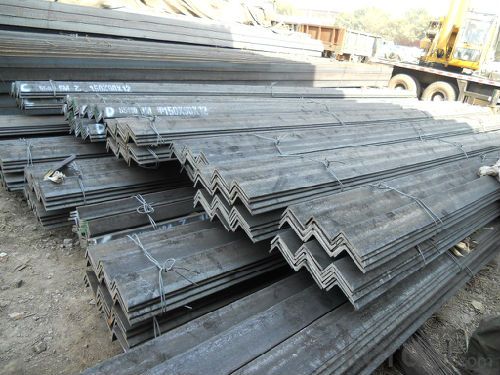
- Q: What are the common industry standards for steel angles?
- The American Society for Testing and Materials (ASTM) primarily determines the common industry standards for steel angles. ASTM A36, widely recognized as a standard for structural steel angles, finds common usage in construction and industrial applications. This standard specifies the chemical composition, mechanical properties, and other relevant characteristics of the steel angles. Another commonly used standard, ASTM A572, is specifically designed for high-strength low-alloy (HSLA) steel angles. It provides guidelines for the chemical composition, mechanical properties, and notch toughness of the angles. Additionally, several other ASTM standards, including A529, A588, and A992, dictate the requirements for specific types of steel angles used in different applications. By ensuring that steel angles meet the necessary quality and performance criteria, these standards enable consistent and reliable use across various industries.
- Q: Can steel angles be used for soundproofing applications?
- Soundproofing applications typically do not involve the use of steel angles. When selecting soundproofing materials, their ability to absorb, dampen, or block sound waves is considered. Steel angles, being rigid and reflective, lack these sound-dampening qualities. Instead, acoustic foam, mass-loaded vinyl, or soundproof drywall are commonly chosen for soundproofing. These materials are specifically designed to absorb or block sound waves, reducing noise transmission between spaces. Consequently, although steel angles have diverse applications in construction and engineering, they are unsuitable for soundproofing purposes.
- Q: Are steel angles resistant to wind loads?
- Yes, steel angles are resistant to wind loads. Steel angles are commonly used in construction for their strength and stability. When properly designed and installed, steel angles provide structural support and can effectively resist the forces exerted by wind. The shape and geometry of steel angles provide rigidity and stability, making them capable of withstanding wind loads without significant deformation or failure. Additionally, steel angles can be reinforced and connected to other structural elements, further enhancing their resistance to wind loads.
- Q: What are the typical uses for steel angles?
- Steel angles have a wide range of uses in various industries and construction projects. One of the most common applications is in structural framing, where steel angles are used to provide additional strength and support to buildings and other structures. They are often used to create bracing, reinforcing, and framing elements in construction projects, such as beams, columns, and trusses. Another typical use for steel angles is in manufacturing and fabrication. They are utilized in the production of machinery, equipment, and vehicles, where their ability to withstand heavy loads and resist bending or warping makes them an ideal choice. Steel angles can be used as frames, supports, or brackets in the construction of various industrial equipment and machinery. Steel angles are also commonly used in the manufacturing of furniture, especially in metalwork and carpentry. They can be used as corner brackets or connectors to provide stability and strength to furniture pieces like tables, chairs, and shelves. Additionally, steel angles are often used in the construction of storage racks and shelving systems, as they offer durability and stability for holding heavy loads. In the transportation industry, steel angles are frequently used in the manufacturing of trailers, truck beds, and frames for various vehicles. Their high strength and resistance to impact and vibrations make them suitable for these applications, ensuring the structural integrity and longevity of the vehicles. Overall, the typical uses for steel angles span across a wide range of industries and applications. Their versatility, strength, and durability make them a popular choice for structural support, manufacturing, furniture construction, and various other projects where robustness and stability are required.
- Q: What are the common design codes or standards for steel angles?
- Structural design of steel angles is governed by various design codes and standards, which guarantee their compliance with safety and performance criteria. The American Institute of Steel Construction (AISC) Manual of Steel Construction is widely recognized as a crucial design code for steel angles. This manual offers comprehensive guidelines and specifications for the design, fabrication, and erection of steel structures, encompassing angles as well. It provides intricate details regarding design strength, allowable stress levels, and geometric properties of angles. Besides the AISC Manual, other design codes and standards may also apply depending on the specific project and location. These include internationally recognized standards such as the Eurocode, British Standards (BS), and Australian Standards (AS). Each of these standards may have slight variations in their requirements for steel angle design and utilization. Therefore, referring to the relevant standard for a specific project is of utmost importance. Moreover, the American Society for Testing and Materials (ASTM) has established standards for the physical and mechanical properties of steel angles. These standards guarantee that the angles satisfy certain quality and performance requirements. Among the most commonly utilized ASTM standards for steel angles is ASTM A36, which outlines general requirements for carbon structural steel. To ensure structural integrity and reliability, common design codes and standards for steel angles provide guidance on crucial factors such as load capacity, strength, and safety considerations. By adhering to these codes and standards, steel angles are designed and employed in a manner that promotes their structural soundness and dependability.
- Q: Can steel angles be fire-resistant?
- Indeed, steel angles possess fire-resistant qualities. Being a material, steel inherently possesses fire resistance due to its high melting point and low thermal conductivity. When faced with elevated temperatures, steel angles can retain their structural integrity and withstand deformation for a significant duration. Furthermore, fire resistance in steel angles can be augmented through diverse approaches, such as the utilization of fire-resistant coatings or the integration of fire-resistant materials in their design. These measures serve to heighten the fire resistance capacity of steel angles, rendering them appropriate for scenarios where fire protection is imperative, such as the establishment of fire-resistant walls, ceilings, and structural systems in construction projects.
- Q: Can steel angles be used for overhead cranes?
- Yes, steel angles can be used for overhead cranes. Steel angles provide structural support and stability to the crane, making them a suitable choice for constructing the framework of overhead cranes. They are strong, durable, and capable of withstanding heavy loads, making them an ideal material for such applications.
- Q: How are steel angles measured and specified?
- Steel angles are measured and specified based on their dimensions, which include the length of the legs and the thickness of the angle. This is typically provided in millimeters or inches. The dimensions are presented in a specific order, such as leg length × leg length × thickness. Additionally, the angle's weight per unit length or its cross-sectional area may also be specified to provide further information about its size and strength.
- Q: What is angle flower? Is it the same as angle iron?
- Welded steel pipe, welded pipe, welded steel pipe, is the same meaning, also called welded steel pipe, seamless steel tube is compared with the. Seamed tube is made of steel plates or strips welded together. Because of the different manufacturing process, it can be divided into longitudinal welded pipe and spiral welded pipe.
- Q: What are the different types of steel coatings available for angles?
- There are several different types of steel coatings available for angles, each with its own unique characteristics and benefits. Some of the most common types include: 1. Galvanized coating: This is one of the most popular and widely used types of steel coating for angles. Galvanization involves applying a layer of zinc to the surface of the steel, providing excellent corrosion resistance. Galvanized angles are commonly used in outdoor applications or in environments where moisture and humidity are present. 2. Powder coating: Powder coating is a type of dry finishing process that involves applying a fine powder to the surface of the steel angles. The powder is electrostatically charged and adheres to the metal, creating a smooth, durable, and attractive finish. Powder coating provides excellent resistance to scratches, chipping, and fading, making it a popular choice for decorative or architectural applications. 3. Epoxy coating: Epoxy coatings are a type of thermosetting polymer that is applied to the surface of the steel angles. These coatings provide exceptional resistance to chemicals, corrosion, and abrasion, making them suitable for harsh and demanding environments. Epoxy-coated angles are commonly used in industrial settings, such as chemical plants or wastewater treatment facilities. 4. Paint coating: Paint coatings are a traditional and cost-effective option for steel angles. They are typically applied as a liquid and can be customized in terms of color and finish. While paint coatings provide some level of protection against corrosion, they may not be as durable or long-lasting as other types of coatings. However, they can still be suitable for indoor or low-corrosion applications. 5. Organic coating: Organic coatings, such as polyurethane or polyester, are often used to provide a decorative or protective layer to steel angles. These coatings offer excellent resistance to UV radiation, weathering, and fading, making them suitable for outdoor applications. Organic-coated angles can be found in architectural, construction, or infrastructure projects. It's important to consider the specific requirements of your application when choosing a steel coating for angles. Factors such as environmental conditions, aesthetic preferences, and durability needs should all be taken into account to ensure the proper selection of the coating that best suits your project.
Send your message to us
Low Carbon Hot Rolled Steel Equal Angle Bars
- Loading Port:
- Tianjin
- Payment Terms:
- TT or LC
- Min Order Qty:
- 100 m.t.
- Supply Capability:
- 20000 m.t./month
OKorder Service Pledge
OKorder Financial Service
Similar products
Hot products
Hot Searches
Related keywords
